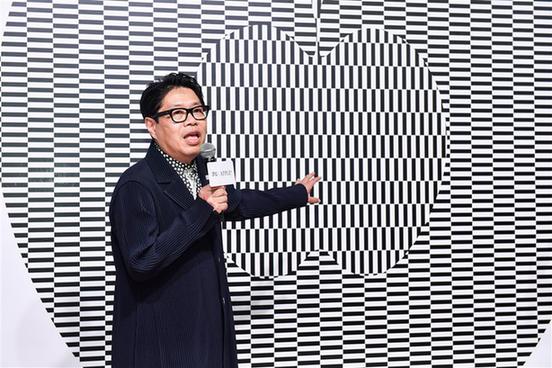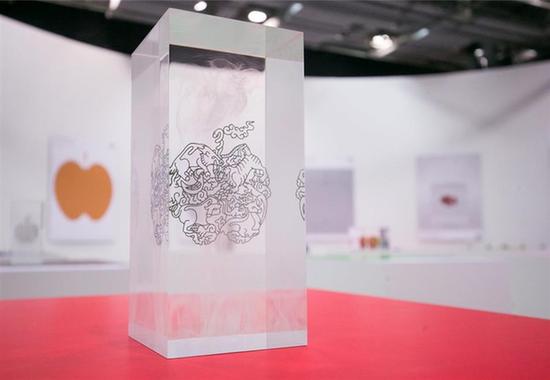An APPLE for thinking, learning and designing
 0 Comment(s)
0 Comment(s) Print
Print E-mail SHINE, November 17, 2017
E-mail SHINE, November 17, 2017
 |
|
Ken Miki's "APPLE+ Learning to Design, Designing to Learn" exhibition [Photo/shine.cn] |
"This is not just to bluff you. There are a sweet red faintly tinged with yellow, a sour red subtly suffused with green and an acerbic red with a generous dose of brown," says Miki, an award-winning Japanese graphic designer based in Osaka.
"We have added 6,000 more colors since I had my first APPLE+ exhibition at the Ginza Graphic Gallery in Tokyo in 2015."
 |
|
Ken Miki explains his design idea at his exhibition in Shanghai. [Photo/shine.cn] |
Over the past five years, Miki, a professor at the Osaka University of Art, has developed a course for freshmen studying design for the first time. Using an apple, something familiar to everyone, he tries to address topics such as color, scale, surface, texture, writing, line and body — fundamentals for all designers.
Altogether 14 activities in Miki's design course are showcased, based on the concept of becoming aware. The forms and characteristics of the apple are used to address various concepts, cultivating insight through such key words as thinking, making, conveying and learning.
One aspect is observing the apple physically and realizing that you don't really know as much about apples as you thought.
 |
|
Ken Miki's "APPLE+ Learning to Design, Designing to Learn" exhibition [Photo/shine.cn] |
What is the surface area of an apple? By peeling off its skin, cutting it into small pieces and arranging them in a rectangle or a square, you can determine the area roughly. But what if you use the little bits to form a map of the world? How big is the area then?
"Having the vision to create a flexible concept is a valuable skill in design," says Miki. "The key is to make your own rule."
Miki says at his design studio, bookshelves are not organized. That means it takes time to find the book you are looking for, but you may also have wonderful and inspiring encounters with other books during the process.
"In this case, happy accident is the rule," says Miki, "because I keep hitting on concepts and ideas. Often my brain hums with delighted inspiration at a passage in a book that I was not originally looking for."
Born in 1955, Miki established his design office, Ken Miki & Associates, in 1982. From that base in Osaka, he has been active in a remarkably broad spectrum of design genres, including branding, advertising, packaging, editorials and spatial design.
Among his most prominent works are his kit created for the 2003 Icograda Congress in Nagoya, promotion materials for IBM Japan for the ThinkPad and logos for BELLE MAISON and KEIKYU Department Store.
In recent years, he has devoted himself to educating tomorrow's designers. In 2015, Miki held the first "APPLE+" design exhibition in Tokyo after winning the 18th Yusaku Kamekura Design Award for his "APPLE+" posters and for his unique approach to education behind their creation.
The book "APPLE" which introduces Mike's course in English was later published by Lars Müller Publishers of Switzerland. With the opening of his "APPLE+" exhibition last month in Shanghai, a Chinese version of the book was published by the Shanghai People's Fine Arts Publication House, with a lot more recently developed content and detailed procedures added.
Q: What does design mean to you?
A: Design has been closely linked to our lives for ages. It is the act of making a smooth connection between people and tangible things, or people and intangible things through communication by identifying a certain state of mind or set of circumstances. Thus, in addition to traversing a professional field, design necessarily embodies a rich sustainable life.
Design visualizes ideas and concepts that provide solutions to a variety of problems. This calls for the discovery of social themes and a special sense of awareness to convert them into new values. And attaining this level of awareness requires profound insight.
Q: How did the APPLE design course come into being? And what's your main objective?
A: At the 13th anniversary of my design firm, Ken Miki & Associates, I accepted a teaching position in the Design Department at Osaka University of Arts. I was asked to oversee a freshman course in basic design practice. After approaching design from a variety of angles during the first year, they will begin to concentrate on a specialty as a sophomore. Not all of them, however, are aiming to become designers in the future.
My aim is to think logically. Open up your senses. Constantly moving back and forth between your intellect and sensitivity is what makes design attractive and enjoyable. Rather than being satisfied with the things we have or striving for more, the real question is how to discover our own way of living. This is what I want to convey to my students.
Q: Why an apple?
A: My goal was to create an accessible workshop that would help my students understand the essential nature of design by the end of this 15-week course. This required content that would get to the heart of design rather than only skimming the surface. I thought that using something familiar to everyone might lead to deeper understanding.
Apples are connected to everything — seeing, hearing, feeling, smelling and tasting. And I thought that by the end of each class, we would be able to digest the content in exactly the same way we eat an apple. By doing this, I thought I could give "awareness" a physical form. But more than that, by choosing an apple, I thought I could make this a "delicious" class.
"APPLE+ Learning to Design, Designing to Learn"
Date: Through December 4, 10am-6pm
Venue: Museum of Contemporary Art Shanghai
Address: Gate 7, People's Park, 231 Nanjing Rd W.






Go to Forum >>0 Comment(s)